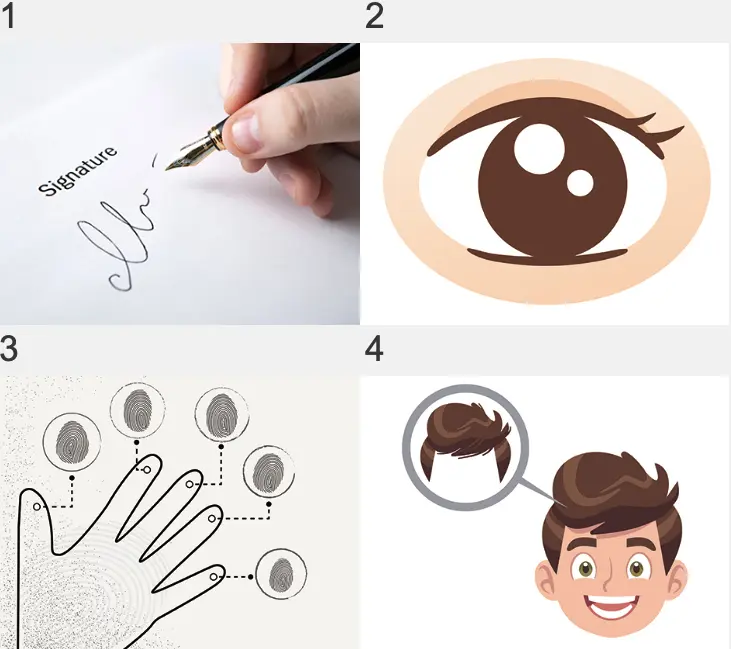
生物辨识: 以个人特征辨认身分 The Rise of Biometrics
The Rise of Biometrics
#阅读测验
9/22 解析英语
作者 Niall Longobardi
阅读时间 10分钟
听讲解 听朗读
本图文出处:
https://www.ivy.com.tw/newsLetter/an...051714064350824MP3:
MP3:生物辨识: 以个人特征辨认身分 The Rise of Biometrics
随着科技越来越融入在我们的日常生活中,新形式也不 断出现。
目录 / More to Learn / Grammar Tips / 中文翻译(& 答案)
阅读测验
As technology becomes increasingly ingrained in our daily lives, new forms continue to emerge all the time. One novel example that you might have heard about is biometrics. This technology is defined as a means of identifying and authenticating a person using biological characteristics. Common biometric types include fingerprint mapping, facial recognition, and retina scans. Biometrics can be used to either authenticate a person’s identity or identify individuals. Biometric authentication involves comparing a person’s data with their previously stored information. In contrast, biometric identification involves comparing a person’s data to that of others in a database to determine their identity.
Biometrics can be classified into two categories: physiological measurements and behavioral measurements. Physiological measurements can be further divided into two sets. Morphological identifiers refer to physical characteristics unique to an individual and that are unlikely to change, including fingerprints and eyes. For a biological analysis, DNA, blood, or urine samples are used. Contrary to physiological measurements, behavioral measurements look at a person’s actions, such as how they talk, walk, and even sign their name.
While biometrics might seem like a new, cutting-edge technology, it has actually been used for over 100 years. Around the turn of the 20th century, police forces in cities like London and Paris began using fingerprints to identify criminals. Law enforcement remains one of the most common fields where biometrics is employed. This includes using advanced technology like Automatic Biometric Identification Systems that can find criminals based on photos. Biometrics has also become widely used for immigration and border control. Many airports now have passengers scan their faces and fingertips upon entry and exit.
While advancements in biometrics can be helpful, there are still concerns. Not all biometric tests are 100% accurate, and some facial recognition programs have been known to misidentify people of color more frequently. Hopefully, as this technology further develops, it will be used in ways that prioritize beneficial applications for society.
1.According to the passage, how does biometric authentication differ from biometric identification?
(A) Biometric identification mainly uses morphological identifiers.
(B) Biometric identification is only used for immigration and border control.
(C) Biometric authentication compares a person’s information to that of other people.
(D) Biometric authentication compares a person’s information to what they previously stored.
2.Which two of the following are NOT morphological identifiers?

(A) 1 & 4. (B) 1 & 3. (C) 2 & 3. (D) 2 & 4.
3. According to the passage, in what way are airports using biometrics?
(A) They are using fingerprints to give people their tickets.
(B) Eye scans are taking place at domestic security checkpoints.
(C) Faces and fingertips are scanned to record who leaves or enters a country.
(D) Automatic Biometric Identification Systems are being used to find criminals at airports.
4. Which aspect of biometrics is NOT discussed in the passage?
(A) Worries about its accuracy.
(B) Examples of how it is used.
(C) Different types of it.
(D) Costs of utilizing it.
答案: 1.D 2.A 3.C 4.D
单字片语整理
Words in Use
●
compare [kəmˋpɛr]
vi. (可与……)匹敌
vt. 把……比作
vt. & vi. 比较
●
identify [aɪˋdɛntə͵faɪ]
vt. 指认,认定;视为同一
vi. 对……感同身受(与介词 with 并用)
●
identification [aɪ͵dɛntəfəˋkeʃən]
n. 身分证明(不可数,缩写为 ID)
●
characteristic [͵kærəktəˋrɪstɪk]
a. 典型的(皆与介词 of 并用)
n. 特征
●
enforcement [ɪnˋforsmənt]
n. 实施,执行
●
immigration [͵ɪməˋgreʃən]
n. 移居(由外移入)
●
beneficial [͵bɛnəˋfɪʃəl]
a. 有益的
●
analysis [əˋnæləsɪs]
n. 分析
●
emerge [ɪˋmɝdʒ]
vi. 出现,冒出(常与介词 from 并用)
●
automatic [͵ɔtəˋmætɪk]
a. 自动的
●
database [ˋdetə͵bes]
n. 资料库
●
prioritize [praɪˋɔrə͵taɪz]
vt. 视⋯⋯为第一优先
●
urine [ˋjʊrɪn]
n. (正式用法) pee
●
advancement [ədˋvænsmənt]
n. 发展,改善
●
cutting-edge [ˌkʌtɪŋˈɛdʒ]
a. 尖端的,最新的
●
ingrained [ɪnˋgrend]
a. 根深蒂固的
●
physiological [͵fɪzɪəˋlɑdʒɪk!]
a. 生理(学)的
●
behavioral [bɪˋhevjərəl]
a. 行为的
●
analyses [əˋnæləsɪz]
n. 分析(复数形)
●
authenticate [ɔˋθɛntɪ͵ket]
vt. 证实
●
authentication [ɔ͵θɛntɪˋkeʃən]
n. 证实
●
morphological [͵mɔrfəˋlɑdʒəkəl]
a. 形态的
●
identifier [aɪˋdɛntə͵faɪɚ]
n. 识别符号
●
fingertip [ˋfɪŋgɚ͵tɪp]
n. 指尖
Practical Phrases
●
be unique to + 地方 为某地方所独有
= be native to + 地方
= be indigenous to + 地方
Kiwi birds are unique to New Zealand. Nowhere else can you find them.
鹬鸵为纽西兰所独有,其他地方都找不到。
●
compare A to B 把 A 比喻为 B
Life is often compared to a long journey.
人生常被比喻为一段漫长的旅程。
●
be classified into 被区分为 A 和 B
●
be beneficial to / for... 对......有益
Exercising on a daily basis is beneficial to your health.
每天运动对你的健康有好处。
●
compare A with B 将 A 与 B 作比较
Some parents like to compare their kids with other kids.
有些父母喜欢拿他们的孩子和别人的孩子作比较。
●
contrary to... 与⋯⋯相反(的是)
Contrary to popular belief, that country is filled with beautiful landscapes.
和一般认知不同的是,那个国家到处都是美景。
●
in contrast 相对地,相较之下
Sarah is usually quiet. In contrast, her brother is always noisy.
莎拉通常很安静。相较之下,她弟弟一向很吵。
●
be divided into 被分成⋯⋯
●
the turn of the + 序数词 + century 在某世纪交替之时
More to Learn
biometrics [ ͵baɪəˋmɛtrɪks ] n. 生物辨识
• With biometrics, you can unlock your smartphone by simply scanning your face or fingerprint.
有了生物辨识,你可以简单地扫描脸部或指纹来解锁你的智慧型手机。
字首 bio- 表「生物」,以下介绍常见单字:
a. biological [ ͵baɪəˋlɑdʒɪk! ] a. 生物学的
• We all have a biological clock that tells us when to sleep and wake up.
我们都有一个生理时钟告诉我们何时该睡觉和起床。
b. biology [ baɪˋɑlədʒɪ ] n. 生物(学)
• My mother’s love for gardening fostered my interest in biology.
我妈妈对园艺的喜好培养了我对生物学的兴趣。
c. biofuel [ ˈbaɪəʊfjʊəl ] n. 生质燃料
biodiesel [ ˈbaɪəʊˌdiːzl ] n. 生质柴油(由植物油或动物脂肪制成的燃料)
• Biofuels are fuels made from plants or animals.
生质燃料是用植物或动物制成的燃料。
d. biodiversity [ baɪo͵daɪˋvɝsətɪ ] n. 生物多样性
• Madagascar is famous for its biodiversity.
马达加斯加以其生物多样性闻名。
e. biodegradable [ ˋbaɪodɪˋgredəb! ] a. 能进行生物分解的
• Some plastic bags are biodegradable.
有些塑胶袋能进行生物分解。
Grammar Tips
Many airports now have passengers scan their faces and fingertips upon entry and exit.
have 当使役动词时,有下列三种用法:
※ have 表「叫(某人做某事)」,可用 make 代替,其后加受词,再以原形动词作补语(本文即为此用法), 形成下列句型:
have + 受词(通常为人)+ 原形动词
叫⋯⋯(某人)做⋯⋯
= make + 受词 + 原形动词
= get + 受词 + to + 原形动词
• Elaine had / made her son fix her phone.
= Elaine got her son to fix her phone.
伊莲叫儿子修她的手机。
※ have 亦可表「把(某物)⋯⋯」,可用 get 代替,此时则以过去分词作受词补语,形成下列句型:
have + 受词 + 过去分词
把⋯⋯(被)⋯⋯(常指请他人代劳,而非亲自做)
= get + 受词 + 过去分词
• Andy had / got his car washed over the weekend.
安迪在周末的时候让人把他的车洗好了。
※ have 加受词后,其后亦可接现在分词作受词补语,强 调动作自然发生或持续进行。句型如下:
have + 受词 + 现在分词 使/让⋯⋯一直(做)⋯⋯
• The singer’s performance had her fans screaming and jumping in the arena.
那名歌手的表演让她的粉丝在会场里又叫又跳。
精选试题
Ken had one of his teeth _____ last Thursday.
(A) pull (B) pulled (C) pulling (D) be pulled
答案:B
中文翻译(& 答案)
随着科技越来越融入在我们的日常生活中,新形式也不 断出现。一个你可能曾听过的新颖例子就是生物辨识技术。 这种技术被定义为使用生物特征来辨识和验证一个人的方 法。常见的生物辨识类型包括指纹映射、脸部辨识和视网膜 扫描。生物辨识可以用来验证一个人的身分,也可以用来辨 别人。生物辨识验证包含将一个人的资料与其先前储存的资 料进行比对。相较之下,生物辨识识别则是将一个人的资料 与资料库中其他人的资料进行比较,以确定其身分。
生物辨识可以分为两类:生理测量和行为测量。生理 测量可以进一步分为两组。型态识别符是指每个人独特的身 体特征,且不太可能改变的,包括指纹和眼睛。在生物分析 中,则使用 DNA、血液或尿液样本。与生理测量相反,行 为测量看的是一个人的行为,例如他们如何说话、走路,甚 至是签名。
虽然生物辨识或许看起来像是一种新的尖端技术,但实 际上它已经被使用了一百多年。在二十世纪之交左右,伦敦 和巴黎等城市的警察开始使用指纹识别罪犯。执法部门仍然 是最常使用生物辨识技术的领域之一。这包含使用能够利用 照片来寻找罪犯的先进技术(如自动生物辨识识别系统)。 生物辨识也已广泛用于移民和边境管制。现在,许多机场都 要求乘客出入境时扫描他们的脸部和指尖。
尽管在生物辨识技术上的进步可能有所帮助,但仍然存 在一些问题。并非所有生物辨识测试都是 100% 准确的,而 且有些脸部辨识程式已知在有色人种的辨识上时常出错。希 望随着这项技术的进一步发展,它能够优先以对社会有用的 方式被应用。
1. 根据本文,生物辨识验证和生物辨识识别有何不同?
(A) 生物辨识识别主要使用型态识别符。
(B) 生物辨识识别只用于移民和边境管制。
(C) 生物辨识验证将某人的资讯与他人的资讯比对。
(D) 生物辨识验证将某人的资讯与其之前储存的资讯作比对。
2. 下列哪两者不是型态识别符?
(A) 1 & 4.
(B) 1 & 3.
(C) 2 & 3.
(D) 2 & 4.
3. 根据本文,机场是如何使用生物辨识的?
(A) 他们使用指纹来给人们机票。
(B) 眼睛扫描在每个国内安检点都有在执行。
(C) 扫描脸部和指尖来记录出入境的人。
(D) 自动生物辨识识别系统在机场被用来寻找罪犯。
4. 本文并未讨论到生物辨识的哪一个面向?
(A) 对其准确性的担忧。
(B) 其如何使用的例子。
(C) 不同种类的生物辨识。
(D) 使用生物辨识的成本。










